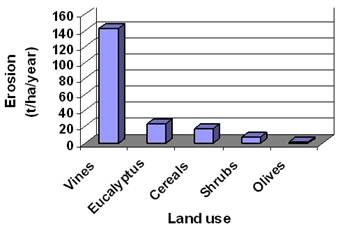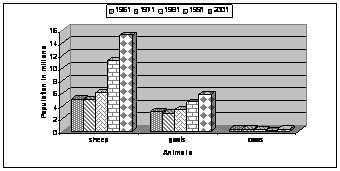Weaknesses of existing land use practices
The main weakness of existing land uses in Crete is attributed to the degree of land protection from soil erosion and desertification. The existing land uses can not be easily changed and corresponds to the more efficient uses that can be grown under the existing environmental and socio-economic conditions of Crete. Land management practices can be easily changed for protecting the land resources from desertification. Studies conducted on soil erosion rates under representative land uses existing in the Mediterranean Europe during the execution of MEDALUS I and II (vines, eucalyptus, cereals, and shrubs) (Figure 9) have been shown that areas cultivated with vines are subjected to the highest erosion rates under the existing land management practices (Kosmas et al., 1996).
Vineyards are usually intensively cultivated in Crete. Soils are usually ploughed twice in mid-spring and in some cases are treated once or twice a year with herbicides. Fertilizers are applied once or twice during winter or early spring. If water is available, vines are irrigated 3 to 5 times during the dry period, usually by drip irrigation. Repeated cultivation of the soils, continuously associated with other cultivation practices, results in decrease in both organic matter content and aggregate stability, thus favouring soil crusting. Usually soils are very susceptible to dispersion. Under such conditions soil crusting can occur very frequently after ploughing, creating favourable conditions for overland flow and erosion. Soil compaction is another form of soil degradation that occurs from repeatedly driving heavy farm equipment over fields. These land use types can be graded in order of decreasing effect on soil erosion as following: vines > eucalyptus > wheat > shrubland > olives, with an average soil loss ranging from 142,8 tones ha-1 yr-1 (vines) to 0,8 tones ha-1 yr-1 (olives) (Figure 11).
Land degradation and desertification in pastures is highly affected by socio-economic factors and land management characteristics such as land ownership, farm size, period of land use, erosion control measures, controlled grazing. Land ownership had greatly affected desertification risk. In several cases, land has been rented and the main concern of the land user was the overexploitation of the natural vegetation without applying any erosion control measures. In the recent decades degraded agricultural land has been abandoned and converted to pasture. In such cases, land present a lower desertification risk because soils are relatively deeper with lower slope gradient than the surrounding pasture land. The period of existing land use type have negatively affected desertification.
Figure 11: Average soil erosion rates measured in various soil, and topographic conditions along the Mediterranean Europe and in representative land uses (Kosmas et al., 1997)
The processes of land degradation can be greatly accelerated by high densities of animals which lead to vegetation degradation and, in turn, to soil compaction and erosion. The number of sheep and goats in the island have almost doubled in the last three decades, while the number of cows remains almost unchanged (Figure 12). Under extreme conditions, overgrazing can actually affect the health and the plant community, even producing a change in species composition.
Figure 12: Changes in the grazing animal population in Crete during the last four decades (Agric. Statistical Service)
The decline in vegetation by overgrazing can result in a loss of those plants which help to maintain soil structure. The herbaceous families that are of particular interest are Leguminosae contributing to the nitrogen fixation in the soil and increase organic matter and Gramineae. These species can protect the soil from raindrop splashing and by increasing the aggregate stability, therefore they can decrease soil erosion.
Shepherds damaged the forest by deliberately setting fires to eradicate the woody vegetation and encourage the growth of grass, which they then overgrazed. Once the land was bare of its vegetative cover and the soil was loosened, the torrential rains of autumn and winter began to wash away the topsoil. In the last fifteen years, there is a significant increase in the frequency and magnitude of forest fires in the area. Man has regularly employed fire as an important tool in land reclamation and bring the land into development for cultivation and grazing. The occurrence of a fire may temporarily increase the productivity of the land. After fire some species generate rapidly, creating favourable conditions for grazing.

